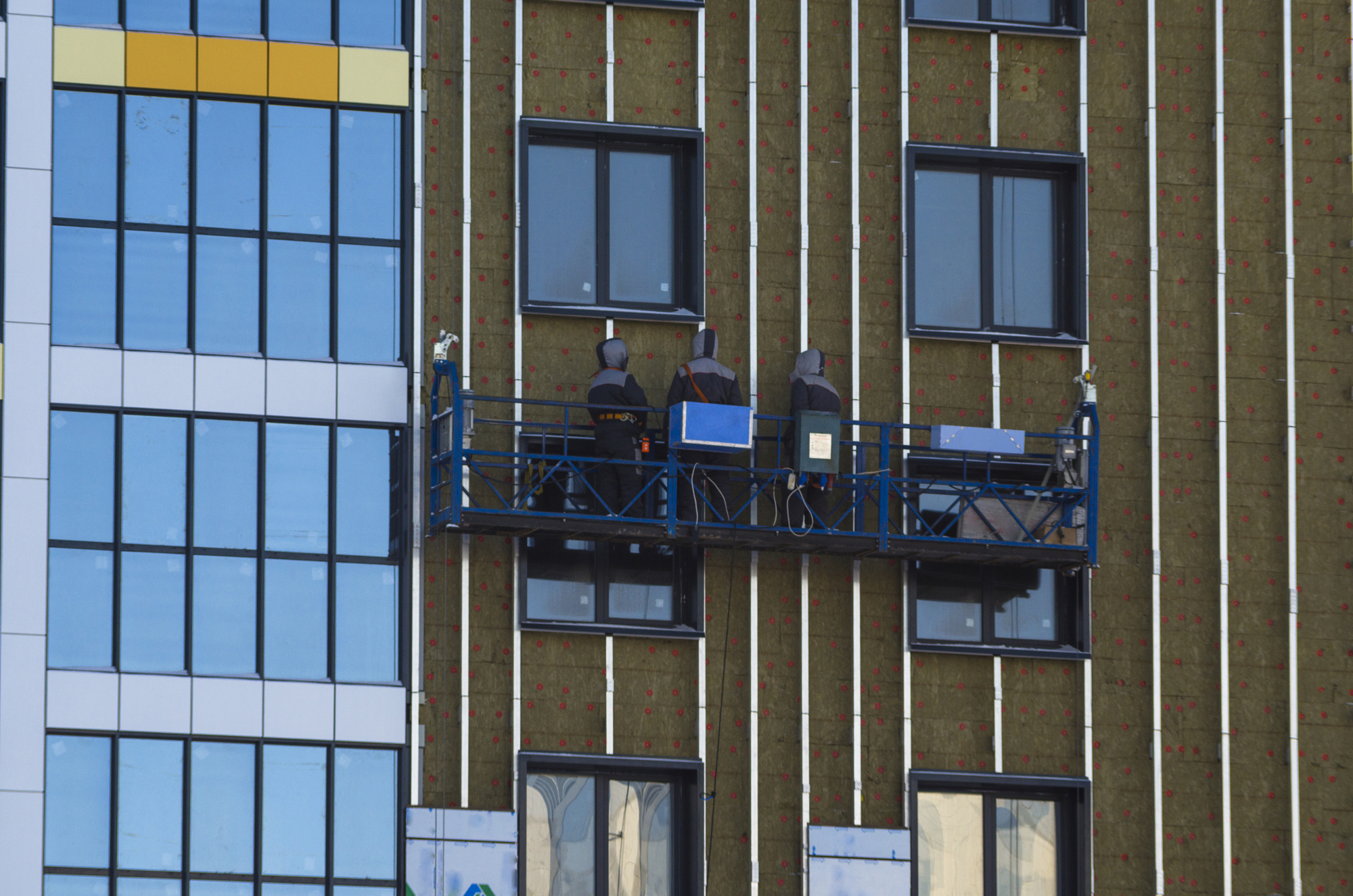
Curtain wallings are widely spread now. In addition to new buildings, they are widely used in old building reconstruction. Their installation allows reducing heat losses and provides a modern look for the building. Curtain wallings are also installed on old brick and block buildings (such as made of breeze blocks), for which a requirement to metal reinforcement electrical continuity is not met. Since the curtain walling has metal cladding supports, a question arises: "Can we use a facade as a lightning arrester?"
Curtain walling design
To simplify, we can describe the curtain walling as follows. The brackets are installed on the wall, to which metal support profiles (guides) are secured.
A thermal insulation layer is attached directly to the wall. An essential function of cladding supports is providing an air gap between the thermal insulation and cladding panels. It is exactly because of the space where air circulates freely such facades are also called "ventilated". Due to the gap, no moistening of the heat insulation and the wall occurs since the moisture is evaporated and flows with air to the gaps between cladding plates.
The first attempt to create unified rules across the entire country was the development of "Recommendations on Designing Attached Facade Systems with Ventilated Air Gaps for Newly Constructed and Upgraded Buildings" (hereinafter referred to as "the Recommendations") in 2002, made by the Central Research Institute of Experimental Design of Houses, which are still effective.
Recently, GOST R 58154-2018 "Materials for substructures of hinged ventilated facade systems. General technical requirements" has been adopted. In particular, according to the standard, the brackets, guides and other securing elements in the curtain walling should be made of one of the following materials:
- - corrosion-resistant steel (stainless steel of austenitic or austeno-ferritic type);
- - zinc-plated steel;
- - zinc-plated steel with the protective polymer coating;
- - compacted aluminum.
The thickness of steel guides should not be less than 0.9 mm, of aluminum guides - not less than 1 to 1.5 mm, depending on the structure.
Varieties of current collectors on a building with curtain walling
A way to arrange lightning arresters on the buildings with curtain wallings is under the cladding plates. Such approach provides one good benefit: the absence of external signs of the presence of lightning protection on the building's facade, and at least two drawbacks.
First, if the lightning arrester is overheated or if the sparks occur due to impairment/loosening of electrical contact between the elements, the flammable heat insulation may ignite. Second, although hidden laying of current collectors is permitted, the requirement of availability of the visual control of current collectors’ integrity on highly dangerous buildings may be reasonably applied. Unfortunately, current collectors located behind the cladding plate and the heat insulator cannot be visually controlled without dismantling them.
An alternative way to arrange special current collectors is over the facade structure. It is sufficiently to only secure the current collector's conductor by using a clamp and a slit between the facade plates. This arrangement option is directly opposite to the hidden laying in terms of its benefits and drawbacks.
To implement the third way, i.e. using metal elements of the curtain walling as natural current collectors, it is important to ensure the compliance with all requirements mandatory for this part of the lightning protection.
The safety here is provided without any compromise in terms of the building appearance!
Using vertical guides of the curtain walling
Two types of metal elements are arranged vertically in the curtain walling: guides and decorative inserts. With that, it is hard to provide electrical continuity of inserts without any harm to their appearance, and not every facade has such inserts. Therefore, the only element of the curtain walling suitable for arranging current collectors is vertical guides. Most often, they are made of a thick metal, and it is possible to meet item 3.2.2.5(a) to minimum cross-section of the natural current collector, according to calculations. Moreover, the air gap that must be present between the guides and the heat insulator allows protecting it against thermal effect.

Vertical guides are a mandatory element of all curtain walling systems
The length of the vertical guide is usually 3 m. It has been chosen for the ease of transportation. In the factory, vertical guides up to 6 m long may be fabricated upon request.
Since thermal expansion ratios of the building wall material and the metal are generally different, the vertical guides located along the same axis are not mechanically connected and a gap is left between them. This approach has been implemented in the "Recommendations".
Thus, in order to provide electrical continuity, the vertical guides arranged along the same axis may be connected with flexible conductors only.
In real life, the electrical connection of the guides with the flexible wire can only be done using a bolt arrangement. If a guide is made of a zinc-plated steel or a zinc-plated steel with the polymer coating, welding will partially damage the anti-corrosion protection, which is not acceptable. Welding of aluminum or stainless steel is too complicated and expensive for such applications.
However, you must not provide electrical connection for all guides. It is only enough to allow for the distance between current collectors according to “Instructions for Building, Structures, and Industrial Utilities Lightning Protection” SO 153-34.21.122-2003, item 3.2.2.3, i.e. 10 to 25 m, depending on the lightning protection category.
Conclusions
In the curtain walling, we can use vertical guides as current collectors for the lightning protection. To do that, we have to ensure their appropriate cross-section and provide continuity and quality of connection elements. We cannot do anything without studying facade structure elements in detail. At first glance, the project seems to be very difficult. Let's study together! Contact professionals from the ZANDZ Technical Center to see that this task can be solved.
Related Articles:



